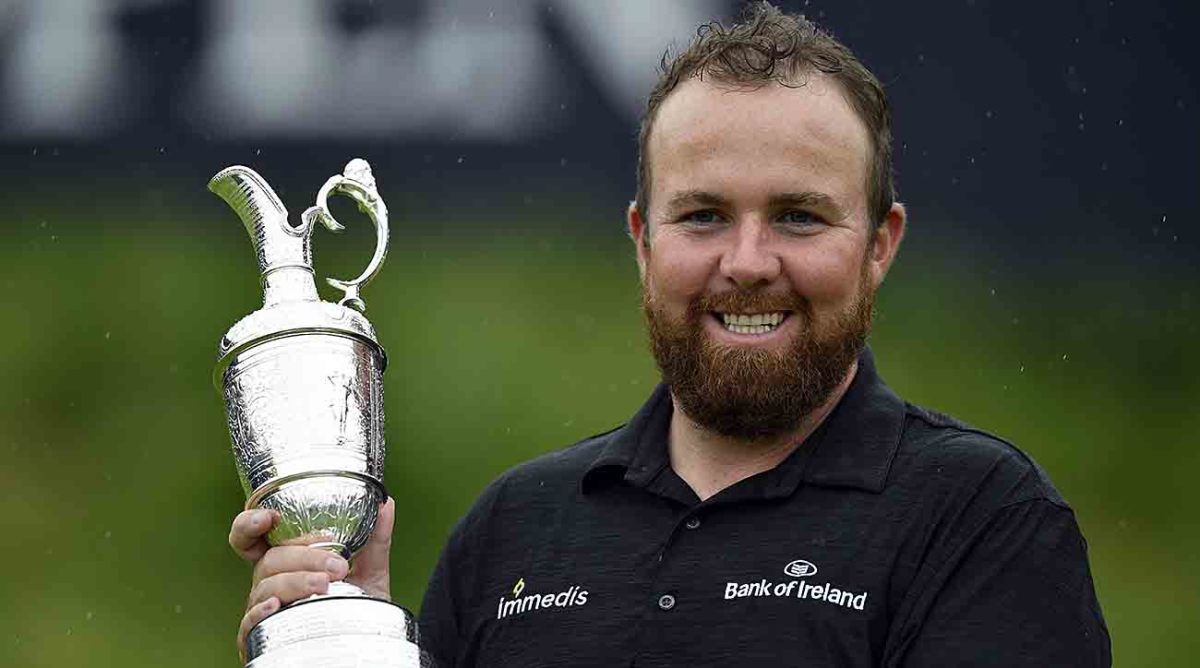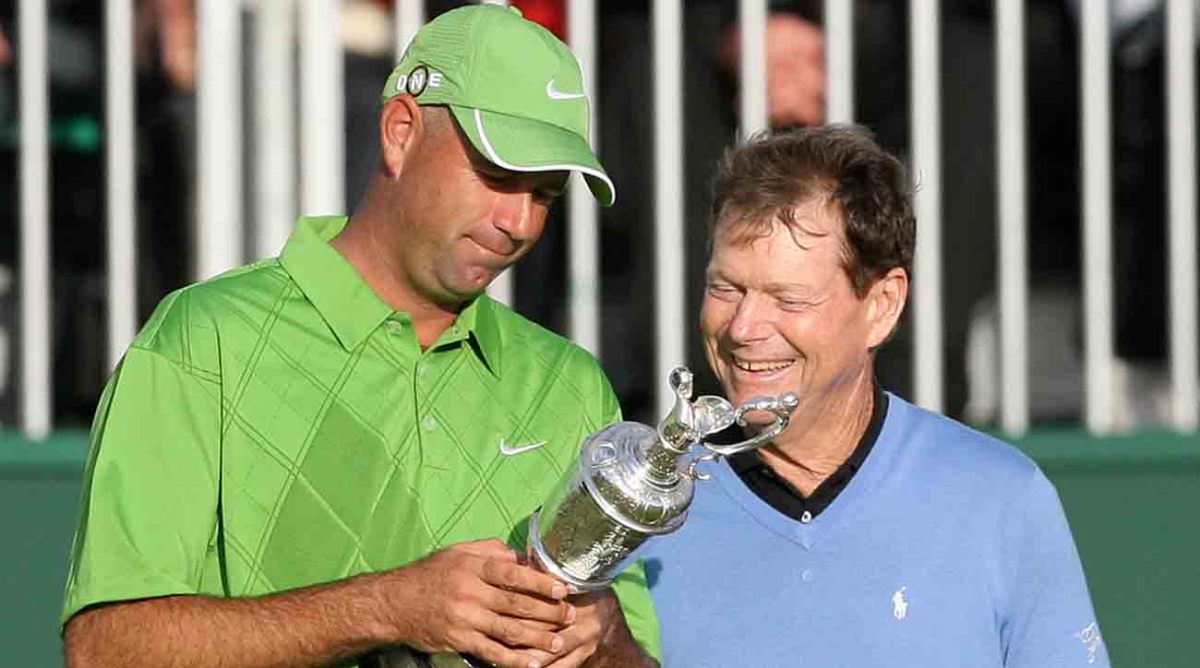Tiger Woods's Triumphs, Tom Watson's Heartbreak and Jordan Spieth From the Range: Ranking This Century's Best British Opens

What makes a great British Open?
A good winner. (And by good, preferably someone whose first name rhymes with Liger.)
An exciting finish. (Enter ex-NFL coach Jim Mora: “Playoffs? Playoffs?!”)
A challenging course. (Yes, gents, Carnoustie accepts your unconditional surrender. Again.)
A superlative performance. (Nineteen under par and, later, 20 under par, counts as superlative.)
A shot for the ages. (Did Jordan Spieth just hit from the practice range? Yes sir.)
All of these factors plus key scoring metrics, drama measurements and even newspaper accounts were analyzed by The Ranking’s state of the art AA-battery-powered Radio Shack 200 computer. Thus, what follows is the greatest ranking of The Greatest Opens of the 21st Century. Just don’t tell Mr. Rhymes With Liger that he’s not No. 1.
10. 2002: The Fab Four
Since the Open was first played at the Dawn of Time, there had never been a four-man playoff until this one at Muirfield. The Ranking awards triple bonus bitcoin points if you can name all four. Sure, South Africa’s Ernie Els and Australia’s Steve Elkington are easy. After that, it gets fuzzy. Aussie Stuart Appleby was in and the biggest factor was the most forgotten man in the group, France’s Thomas Levet. By the way, Gary Evans and Padraig Harrington bogeyed the 72nd hole or it could have been a wild six-man shootout. Some superb golf was played in the final round as Appleby posted 65 while Levet and Elkington shot 66s. Els had a one-shot lead until he doubled the 16th but birdied the 17th and parred 18. Levet needed a par at 18 to win but, three years after the legend of Jean Van de Velde, made bogey. Levet bogeyed the 18th in the playoff, too, and lost when Els hit a memorable bunker shot to save par. “I’ve been after this for 10 years,” Els said.
9. 2019: The Magically Delicious Open
You didn’t have to be Irish to have goosebumps and maybe moist eyes when Ireland’s Shane Lowry walked to the 72nd green, hat in one hand and other arm upraised in a gesture of pride, gratefulness and disbelief. The Open returned to Northern Ireland’s Portrush for the first time in 68 years and an Irishman won it? The drama was not on the scoreboard—Lowry won by six, thanks to a brilliant third-round 63 that enabled him to break away. The drama was in watching a country anxiously wait to start the Irish pride party of the century for a victory it will never forget. “It was an out-of-body experience,” Lowry said. But, luckily, not an out-of-Guinness experience.

8. 2005: The Goodbye Guy
Jack Nicklaus made a tearful exit from Open competition, posing on the Swilcan Bridge for one last time. Meanwhile, Tiger Woods completed the Farewell Slam, winning each of the majors where Nicklaus announced it was his last appearance. The tournament didn’t have much drama. Woods once again overpowered the Old Course and the field, winning by five shots over Colin Montgomerie, who said, “Can he achieve the impossible? He’s on his way.” It was Woods’ 10th major title and if he hadn’t chunked a chip shot and missed a short putt a month earlier at Pinehurst, where Michael Campbell won the U.S. Open, Woods would have gone to August’s PGA Championship with a chance to win a calendar-year Grand Slam to match his 2001 Tiger Slam when he won four majors in a row. Woods was the first wire-to-wire Open champ in 32 years.
7. 2006: Tears for Fears
Royal Liverpool hosted the Open for the first time since 1967 and didn’t disappoint. A heat wave and drought turned the course a crispy brown for the Open and Tiger Woods had a game plan for the fast-running conditions: He used driver only once in four days, hitting long irons off most of the holes to keep his ball in play. Woods won by two over Chris DiMarco and played in the final pairing with Spain’s Sergio Garcia, who dressed in an all-yellow outfit that led to a mean tabloid headline the next day: “Sergio, You’ll Never Be Top Banana.” Most memorable, however, was how Woods fell into the arms of caddie Stevie Williams and shook with tears on the final green after winning his first major without his father, Earl, who passed away a few months earlier. It was startling proof that Woods, the greatest golfer of a generation, was human after all.
6. The 'Oh No Not Again' Open
Eight years after Van de Velde famously butchered Carnoustie’s 18th hole when victory was in his grasp, Ireland’s Padraig Harrington nearly duplicated the dubious achievement. Harrington hit two balls into the last hole’s Barry Burn and got up and down for a double bogey.
That meant Sergio Garcia, who led by three after 54 holes and was six shots ahead of Harrington then, could win with a par at 18 but he found a greenside bunker and missed an eight-foot putt that forced a playoff. Harrington was up two shots after the first extra hole and held on to become the first Irish golfer in 60 years to win the Open. Regarding his early off-kilter play, Garcia said, “If you’re trying to win an Open championship and you’re leading and you’re not nervous, you must be dead.”
5. 2022: Aussie rules
The Old Course galleries were primed to celebrate Rory McIlroy as an Open champion at St. Andrews but Cameron Smith had other ideas. Smith became the first Australian to win the Open at St. Andrews since 1960 and he did it with the best closing round ever seen at the Old Course, an 8-under 64. Smith’s 20 under total tied the Open’s scoring record. Smith began the final round four shots behind McIlroy but he made five birdies in a row on the final nine, including a two-putt birdie at the 18th after driving the green. This Open also had a charge from American Cameron Young, who eagled the 18th hole and forced Smith to make his birdie putt for the win. Plus, Tiger Woods missed the cut in what was likely his final visit to St. Andrews.
4. 2000: The Tiger Effect
All right, there was little in the way of actual drama at the Old Course. Do you remember a single shot played by the champion, Tiger Woods? Probably not. Woods won this thing by eight shots over No One Cares. But it was epic golf to watch Woods dominate the course with his power and strategy. Woods never hit into a bunker on the Old Course as he showed his superiority and the course’s obsolescence. He shot 19 under par, a major record score that held up for 15 years, and at 24 became the youngest player to win the Career Grand Slam. "The guy is simply in a different league," six-time major champ Nick Faldo said.
3. 2016: The Dynamic Duo
Welcome to one of the Open’s best final-round showdowns, starring Phil Mickelson and Sweden’s Henrik Stenson. Three years earlier, Mickelson beat Stenson by three shots at Muirfield. This time, Mickelson charged home with a stellar 65 and … lost ground? That’s right because Stenson stacked 10 birdies, four on the last five holes, shot 63 and posted the Open scoring record at 20 under par. The two men put on such a dominant display that third-place finisher J.B. Holmes won the B Flight, coming in 11 strokes behind Mickelson, whose score of 267 would have won or tied 141 of the 145 Opens played. “We’ll never see perfection on a links like that ever again in our lives,” said Nick Faldo, three-time Open champion.
2. 2009: The 59 Watch
It was a mesmerizing, tantalizing thought for three days that a 59-year-old might win the Open at Turnberry. And not just any 59-year-old but five-time Open champion Tom Watson, a beloved golfer in Scotland. Lee Westwood was in the mix but faded during the final round. At the 72nd hole, Watson needed a par to join Old Tom Morris as the only six-time Open champs. Watson’s 8-iron shot seemed perfect when it landed on the front of the green. But then it careened just over the green. From there, Watson putted it eight feet past, a poor stroke, then made an awful attempt at the winning par putt. Clearly drained, Watson was overwhelmed by Stewart Cink in the four-hole playoff. Watson tried to lighten the somber mood in the media center by joking, “Hey, it’s not a funeral.” Sorry, old-timer, it sure felt like one. It was unforgettable.

1. 2017: The Range Finder
It may have been the craziest 15 minutes in Open history. Jordan Spieth held the lead all weekend at Royal Birkdale until the 13th hole Sunday, when he sent his tee shot so far right it ended up on the practice range. After lengthy rules consultations, he took a penalty drop, played from the range and gamely salvaged a bogey that gave Matt Kuchar the lead. Shortly after that, however, Spieth went on a birdie-eagle-birdie-birdie spree that included a 70-foot eagle putt at the 15th. “Go get that!” Spieth gleefully chirped at his caddie, Michael Greller. Spieth’s recovery was scintillating. Kuchar’s overshadowing was stunning. Said Kuchar, who finished three shots back, “That certainly was quite a show.”

